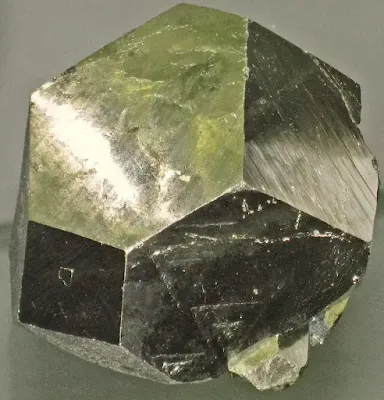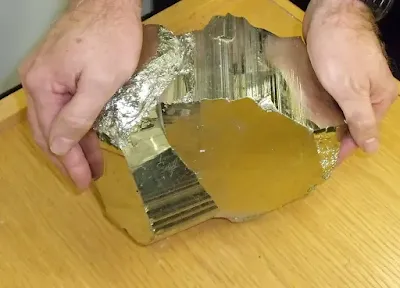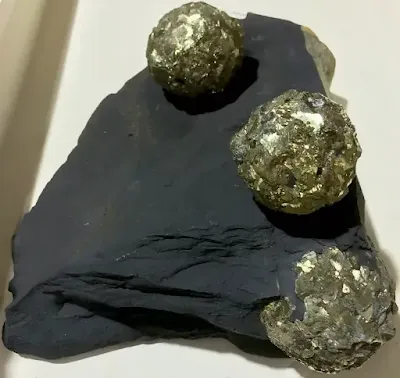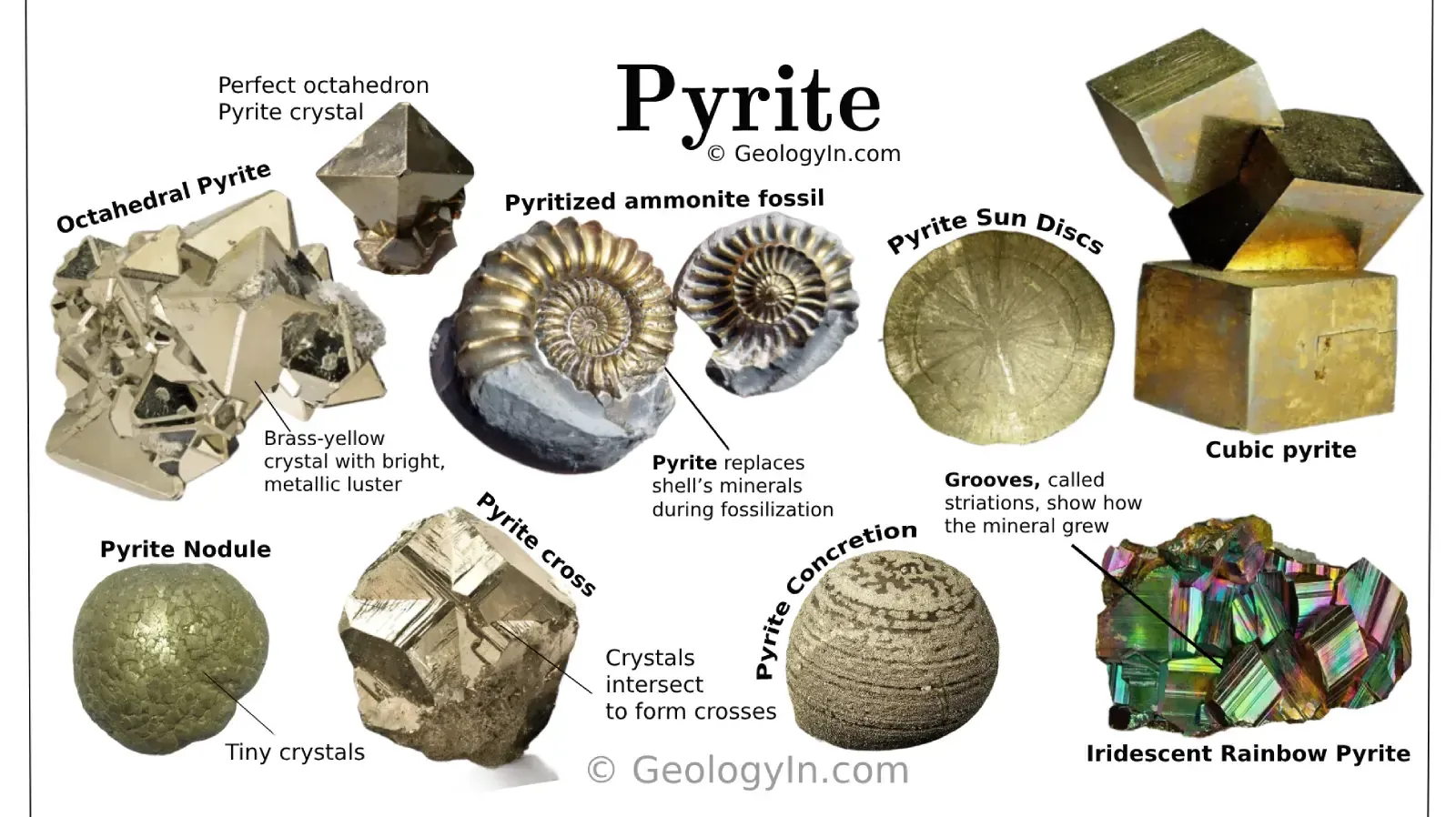Pyrite: Properties, Uses, Occurrence, Toxicity
Pyrite is a naturally occurring mineral composed of iron and sulfur, with the chemical formula FeS₂. It belongs to the sulfide group of minerals and is known for its metallic luster and brass-yellow color, often mistaken for gold, hence the nickname "fool's gold."
Pyrite is found in a wide variety of geological environments, including igneous, metamorphic, and sedimentary rocks. It is often associated with other sulfide minerals, such as chalcopyrite and sphalerite. Pyrite can also be found in coal beds, where it can form large concretions.
Pyrite gets its name from the Greek word "pyr," meaning "fire," due to its ability to produce sparks when struck against metal or another hard material.
Occurrence
Pyrite is one of the most abundant sulfide minerals on Earth and exhibits a remarkable ubiquity across various geological settings. Its presence can be found in:
Sedimentary Rocks
Accessory Mineral: Pyrite is a common accessory mineral within sedimentary rocks such as shale, sandstone, and carbonaceous siltstone or shale. This means it is present in small quantities but contributes to the overall composition of the rock.
Fossil Replacement: Pyrite can sometimes pseudomorphically replace fossils preserved within these sedimentary rocks. Pseudomorphism refers to the process where a mineral replaces another mineral while retaining the original shape.
Coal Deposits: In specific instances, particularly within coal deposits, pyrite may be present as discrete nodules or bands. These inclusions can contribute to the phenomenon of spontaneous coal combustion due to pyrite's ability to oxidize and generate heat.
Igneous Rocks
Magmatic Segregation: Pyrite occurrence within igneous settings is less frequent compared to sedimentary environments. However, it can be present as a result of magmatic segregation. This process involves the separation of immiscible sulfide phases, including pyrite, from a molten rock body during its cooling and solidification.
Hydrothermal Mineral: Pyrite can also form as a high-temperature hydrothermal mineral within igneous environments. Hydrothermal fluids are hot, mineral-rich fluids that circulate through cracks and fractures in rocks. As these fluids cool, they can deposit various minerals, including pyrite.
Metamorphic Rocks
Contact Metamorphism: Pyrite formation can occur within metamorphic rocks subjected to contact metamorphism. This process involves the transformation of existing rocks due to the elevated temperatures and pressures associated with igneous intrusions. During contact metamorphism, existing minerals can react and recrystallize, sometimes forming pyrite.
Hydrothermal Veins
Pyrite is frequently encountered in hydrothermal vein deposits. These features arise from the circulation of hot, mineral-rich fluids through fractures within the rock mass. As these fluids cool and experience changes in pressure, they can precipitate various minerals, including pyrite and other sulfide minerals. Pyrite can be a major component of some hydrothermal vein deposits.
 |
| Hydrothermal pyrite vein, Woodville Canyon, near Butte, Montana, USA Photo: James St. John |
Pyrite Characteristics & Properties
Composition: Pyrite is composed of iron disulfide (FeS₂), Pyrite is an iron sulfide, meaning it's a compound formed by iron (Fe) and sulfur (S) atoms in a 1:2 ratio. This composition contributes to its metallic luster and hardness.
Color: Pyrite typically exhibits a brassy yellow color, although it can also range from pale gold to darker bronze or even black when oxidized.
Transparency: Pyrite is opaque, Light cannot pass through pyrite crystals. This is because the iron and sulfur atoms block light penetration.
Luster: Metallic - This property gives pyrite its characteristic bright, shiny look, resembling polished metal. This luster is a giveaway that it's not gold, as gold has a more subdued metallic shine.
Crystal System: Pyrite crystallizes in the "Isometric" cubic system, forming cubic, octahedral, or pyritohedral crystals. It can also occur in massive or granular forms.
Streak: The streak of pyrite is greenish-black to brownish-black. This is the color of the powdered mineral when scraped against an unglazed porcelain plate.
Hardness: Pyrite has a hardness of about 6 to 6.5 on the Mohs scale,Pyrite is moderately hard and can scratch glass. However, it's more brittle than gold, which can be bent without breaking. This difference in hardness helps identify pyrite in the field.
Cleavage: None, Unlike some minerals that break along specific planes, pyrite doesn't have a preferred cleavage direction. It fractures irregularly when broken.
Fracture: The fracture of pyrite is typically uneven to conchoidal. Pyrite breaks with a rough, uneven surface. Sometimes, the fracture can have a curved, shell-like appearance (conchoidal fracture).
Habits and Forms: Massive, Cubic, Octahedral, Pyritohedral, Radiated, Granular. Pyrite can be found in various shapes and forms. It can occur as solid masses, perfect cubes, eight-sided shapes (octahedrons), complex crystal structures (pyritohedrons), radiating clusters, or even as tiny grains (granular).
Density: The density of pyrite ranges from approximately 4.9 to 5.2 grams per cubic centimeter. This high density gives it a heavy feel for its size, another clue that it's not gold (which is much denser than pyrite).
Tenacity: Brittle - Pyrite can shatter or break easily when struck with force, unlike gold which is malleable and can be shaped without breaking.
Solubility: Insoluble in Water, Weakly Soluble in Acids - Pyrite is resistant to water and won't readily dissolve. However, strong acids can slowly break it down over time.
Magnetism: Non-Magnetic. Pyrite is not attracted to magnets. This property helps distinguish it from some iron-bearing minerals that are magnetic.
Fluorescence: Pyrite doesn't glow under ultraviolet light. This might be useful for identification in some situations.
Pleochroism (Absent): Pyrite doesn't exhibit pleochroism, which is the property of showing different colors depending on the viewing direction.
Refractive Index: Pyrite has a refractive index ranging from approximately 1.87 to 2.10. This is a technical measurement of how light bends as it passes through pyrite. It's less relevant for field identification but important for mineralogical analysis.
Inclusions: Pyrite may contain various inclusions. Pyrite crystals often contain tiny trapped bubbles of other minerals or gases as inclusions. These inclusions can sometimes affect the overall appearance of the pyrite.
Best Field Indicators: Brassy-Yellow Color, Metallic Luster, Cubic or Octahedral Shapes, Greenish-Black Streak. These are the easiest ways to identify pyrite in the field. The combination of its yellowish color, metallic shine, cubic or eight-sided shapes, and diagnostic greenish-black streak helps differentiate it from gold and other minerals.
 |
| Pyrite truncated octahedron crystal |
Pyrite Varieties
Pyrite Varieties based on Form:
- Cathedral Pyrite: Pyrite with etched, gothic-like markings, resembling cathedral windows.
- Dollar Pyrite (Pyrite Sun): These are flat, disc-shaped pyrite crystals with a radiating structure, sometimes mistaken for marcasite (another iron sulfide mineral).
Pyrite Varieties based on Crystal Shape:
- Pyrite Cube: Large, undistorted, cubic shaped pyrite crystal.
- Pyritohedron: Pyrite crystals with a twelve-sided shape formed by a combination of cube and octahedron faces. This is the typical crystal habit for pyrite, not necessarily a distinct variety. This is the most common crystal habit for pyrite.
Pyrite Varieties based on Crystal Form:
- Hepatic Pyrite: This term can be misleading as it sometimes refers to liver-colored marcasite, a different iron sulfide mineral.
- Telaspyrite: Previously thought to be a tellurium-bearing pyrite variety, telaspyrite is now recognized as a mixture of other minerals.
Bravoite
Bravoite: This is sometimes referred to as a nickel-cobalt bearing variety of pyrite. However, it's not a formally recognized mineral. Bravoite has a significant amount of nickel (Ni) replacing iron (Fe) in its structure, exceeding 50% substitution.
Polymorphs
Marcasite is a polymorph of pyrite, meaning they share the same chemical formula (FeS₂) but have different crystal structures. Pyrite crystallizes in the isometric system (cubic or octahedral shapes), while marcasite crystallizes in the orthorhombic system (often with a prismatic or radiating habit).
Rainbow Pyrite
Rainbow pyrite, also known as iridescent pyrite or peacock pyrite, is a captivating mineral variation known for its stunning metallic luster and a rainbow of colors that can be seen on its surface.
Unlike the typical pale yellow color of pyrite, rainbow pyrite exhibits a dazzling display of colors like blue, green, purple, gold, and pink. This iridescence is caused by thin layers of iron oxides or other secondary minerals that form on the surface of the pyrite crystals. These layers diffract light, creating the mesmerizing rainbow effect.
 |
| Iridescent Rainbow Pyrite from Peru. |
Locations and Distribution of Pyrite
Pyrite is incredibly widespread and can be found all over the world. Here are some locations known for producing particularly beautiful or interesting pyrite specimens:
Spain: Spain has a long history of pyrite mining, dating back to the Bronze Age. Some of the most popular and well-regarded pyrite crystals come from Spain, particularly the cubic crystals found in limestone at Navajun.
Italy: Elba and Piedmont are two Italian regions known for their pyrite deposits. Elba even has a unique dodecahedral pyrite variety, sometimes called a "pyritohedron."
United States: The US has many locations with pyrite, including Colorado, Illinois, Arizona, Pennsylvania, Vermont, Montana, Washington, and Missouri. Places like Sparta, Illinois are known for their "pyrite dollars," flattened concretions filled with pyrite.
Peru: Peru is a major producer of pyrite, and the country has many localities where well-formed pyrite crystals can be found.
Russia: South Ural Mountains, This region contains several pyrite deposits, some associated with copper and zinc.
Portugal: Wolframite Belt, Pyrite is found alongside other valuable minerals like wolframite (tungsten ore) in this belt.
Kazakhstan: This country also has pyrite deposits.
 |
| Huge pyrite from Peru |
Pyrite Uses
Pyrite has several uses and applications across various industries and fields:
Modern Applications
Sulfur Production: Pyrite is a significant source of sulfur , which is extracted by roasting the mineral in the presence of oxygen. The sulfur dioxide produced is then converted into sulfuric acid, This vital industrial chemical has numerous applications, including:
- Fertilizer production
- Battery electrolytes
- Water treatment
- Metal processing
- Pigments.
Iron Ore: Pyrite can be a source of iron, but it's not a primary iron ore due to the lower iron content compared to dedicated iron ores like hematite or magnetite. However, in some cases, pyrite deposits with high iron content might be economically viable for iron extraction.
Gold Extraction: Although not a primary source of gold itself, pyrite often occurs alongside gold deposits. During the processing of gold-containing ores, pyrite can be a valuable indicator mineral, helping miners locate areas with higher gold concentrations.
Lithium Metal Battery Cathode: Pyrite shows promise as a cathode material in certain types of lithium metal batteries, potentially offering a more cost-effective alternative to traditional materials. This is a developing area of research.
Semiconductor Material: Pyrite exhibits semiconducting properties, making it a potential candidate for future electronic applications, although currentresearch is ongoing.
Sulfur Dioxide Production: The thermal decomposition of pyrite generates sulfur dioxide, which is used in the paper industry for bleaching wood pulp.
Geological Exploration: Pyrite serves as an indicator mineral for the presence of hydrothermal ore deposits, including those containing gold, copper, zinc, and other valuable metals. Its presence in rocks can help geologists identify areas with potential mineral resources.
Jewelry and Ornamental Use (Limited): Despite being called "fool's gold," pyrite has been used historically as an ornamental stone and in jewelry. Its metallic luster and brassy yellow color can resemble gold, making it an attractive and less expensive alternative.
Historical Significance
Fire Starter: Pyrite's ability to spark when struck against steel made it a valuable tool for early humans. This property allowed them to create fire, a crucial element for survival, warmth, and cooking.
Mirrors: Polished pyrite was used by some cultures, like the Native Americans, to create reflective surfaces before the invention of glass mirrors.
Cultural Symbol: In some cultures, pyrite has held symbolic meaning. For instance, in ancient Egypt, it was associated with the god Osiris, symbolizing rebirth and the afterlife. Similarly, some Native American tribes believed pyrite offered protection from evil spirits.
Despite its diverse applications, pyrite also poses challenges and hazards, particularly in mining and environmental contexts. Pyrite-rich rocks can contribute to acid mine drainage, a significant environmental issue characterized by the release of sulfuric acid and heavy metals into waterways. Therefore, proper management and mitigation strategies are essential when dealing with pyrite-containing materials in industrial and mining operations.
 |
| Coarsely-crystalline pyrite concretions from the Devonian of Indiana, USA. Photo: James St. John |
Pyrite Vs Gold: How to tell the difference
Pyrite and gold are often mistaken for one another because they both have a shiny, yellow appearance. However, there are several key differences between the two minerals.
Composition: Gold is a pure element (Au), whereas pyrite is a compound made of iron and sulfur (FeS₂).
Color: Gold has a bright, sunny yellow color, while pyrite has a paler, brassy yellow color.
Shine: In good lighting, real gold maintains a consistent shine from all angles. Pyrite's shine is more like polished brass, appearing brighter when catching the light at a specific angle.
Malleability: Gold is very malleable, meaning it can be hammered or pressed into thin sheets without breaking. Pyrite, on the other hand, is brittle and will shatter if struck with force.
Hardness: Gold is a soft metal, with a Mohs hardness rating of 2.5 to 3. Pyrite is harder than gold, with a Mohs hardness rating of 6 to 6.5. Mohs hardness is a way of measuring the relative scratch resistance of minerals.
Crystalline Shape: Gold does not have a specific crystalline shape, while pyrite often forms cubic or pentagonal dodecahedral shapes with sharp edges and corners.
Streak: When scratched against a streak plate (a piece of unglazed porcelain), gold leaves a yellow streak. Pyrite leaves a greenish-black streak.
Density: Gold is much denser than pyrite. While this isn't a practical field test, if you have a very precise scale, gold will be significantly heavier than pyrite of the same size.
Odor: Pyrite has a faint sulfurous odor, similar to rotten eggs. Gold is odorless.
In summary, while pyrite and gold may appear similar at first glance, they differ significantly in composition, color, hardness, density, and value. Gold is a precious metal valued for its rarity and beauty, while pyrite is a mineral composed of iron and sulfur, prized more for its geological significance and industrial uses than its monetary value.
 |
| Pyrite sun disks (sand dollar) in black shale from the Pennsylvanian of Illinois, USA. |
Toxicity: Is pyrite harmful?
Pyrite itself is generally not considered harmful to touch or handle in its natural state. However, there are a few things to keep in mind:
Dust: Inhaling pyrite dust over long periods can irritate the lungs. This is a concern primarily for miners or those working in environments with significant amounts of airborne pyrite dust.
Oxidation: When exposed to air and moisture over time, pyrite can oxidize and produce sulfuric acid. This acidic environment can cause some metals to corrode and may be harmful to some building materials like concrete. This is a concern for long-term storage or use of pyrite and for its potential impact in some geological settings.
Toxic Elements: Some pyrite deposits may contain trace amounts of toxic elements such as arsenic, lead, and other heavy metals. When pyrite-bearing materials are crushed, weathered, or exposed to acidic conditions, these toxic elements can be released into the environment, posing risks to human health and ecosystems.
Sewage Treatment Plants: While uncommon, pyrite can be problematic in sewage treatment plants. In certain conditions, it can contribute to the formation of hydrogen sulfide gas, which is toxic and has a rotten egg odor.
Acid Mine Drainage (AMD): One of the most significant environmental hazards associated with pyrite is the phenomenon known as acid mine drainage. When pyrite-containing rocks are exposed to oxygen and water, they undergo chemical reactions that produce sulfuric acid. This acidic runoff can leach heavy metals from surrounding rocks and soil, contaminating waterways and harming aquatic life.
Arsenopyrite Confusion: Pyrite can sometimes be mistaken for arsenopyrite, a mineral that contains arsenic. Arsenic is a toxic element, and exposure can cause health problems. It's important to have a proper identification of the mineral if handling large quantities.
Overall, pyrite is a relatively safe mineral as long as proper handling procedures are followed, especially when dealing with large quantities or dust. If you have any concerns, it's always best to consult a professional or wear appropriate protective gear.
 |
| Pyrite nodules in black carbonaceous shale from the Hamersley Basin, Western Australia, Australia. |
How can I tell if my home is affected by pyrite?
There are a number of signs that may indicate that your home is affected by pyrite. These include:
Visual Signs:
Cracks in foundation, walls, and floors: Pyrite can cause the foundation, walls, and floors to heave or lift as the pyrite expands due to oxidation. This can result in cracks with diagonal patterns or radiating outwards from windows and door frames.
Uneven floors: Uneven floors with tiles or other surface materials that are cracked or lifted can be an indicator of pyrite issues.
Sticking doors and windows: Doors and windows that become difficult to open or close due to movement in the foundation or walls can be a sign of pyrite problems.
Spalling (flaking) of concrete.
These signs can also be caused by other factors unrelated to pyrite. If you suspect pyrite problems in your home, it's crucial to get a professional inspection from a qualified engineer or surveyor experienced in dealing with pyrite issues. They can assess the situation, confirm the presence of pyrite, and recommend the necessary course of action.
Conclusion
In conclusion, pyrite is a mineral of significant geological and industrial importance due to its distinctive properties, diverse uses, and widespread occurrence. Despite its resemblance to gold and its nickname "fool's gold," pyrite has distinct chemical and physical characteristics that differentiate it from the precious metal. Understanding the properties, uses, and occurrence of pyrite is essential for its proper identification, utilization, and geological interpretation.
Read also:
Pyrite: Facts About Pyrite "Fool's Gold"
Peacock Rock
“Invisible” Gold – Fool’s Gold Actually Contains Real Gold


%20(1).webp)






